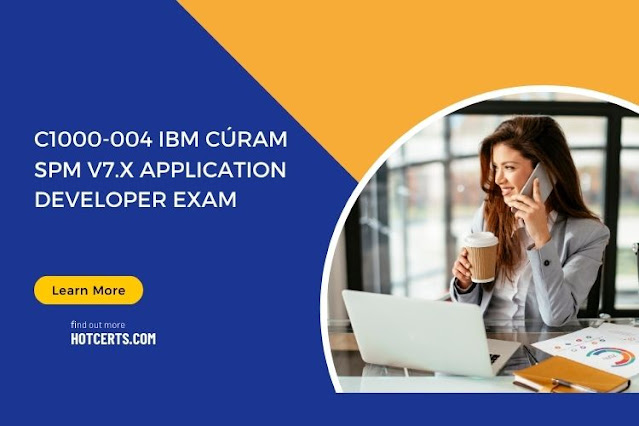C7010-013 IBM Cúram V6.0.5 Business Analysis and Design Exam: Mastering the Essentials
Introduction:
Are you aspiring to enhance your expertise in business analysis and design? The C7010-013 IBM Cúram V6.0.5 Business Analysis and Design Exam is your pathway to demonstrating your proficiency. This comprehensive guide will equip you with the essential knowledge and strategies to excel in the exam. Whether you're a seasoned professional seeking to validate your skills or a newcomer aiming to establish a strong foundation, this article has you covered.
Understanding Cúram Solutions
The business analysis and design world is rapidly evolving, and IBM Cúram Solutions has emerged as a cornerstone of modern enterprises. These solutions offer a comprehensive suite of tools and frameworks to streamline business processes, enhance customer experiences, and optimize resource allocation. In the contemporary business landscape, proficiency in understanding and leveraging Cúram solutions is a valuable skill set that can drive organizational success.
Core Concepts and Terminology
Before delving into the specifics, it's crucial to grasp the core concepts that underpin business analysis and design. Business analysis involves identifying business needs and finding technological solutions to address them. On the other hand, design focuses on creating a blueprint for the solution, ensuring it aligns with business requirements and user expectations. Familiarizing yourself with these fundamental concepts provides a strong foundation for the remainder of your preparation.
Requirements Gathering
Efficient requirements gathering is at the heart of successful business analysis and design. This involves engaging with stakeholders to understand their needs, documenting requirements clearly, and prioritizing them based on their significance. Collaboration is critical during this phase, ensuring the solution aligns with stakeholder expectations and effectively addresses real-world challenges.
Process Modeling
Process modeling is a visual representation of workflows, helping analysts identify bottlenecks, redundancies, and opportunities for optimization. By mapping out business processes, you gain a holistic view of how different components interact, allowing you to propose efficient and effective solutions. Process modeling forms the basis for process improvement, which can significantly enhance operational efficiency.
Data Analysis and Design
Data is the backbone of any business solution. Data analysis involves identifying relevant data points, understanding their relationships, and ensuring data accuracy and integrity. Proper data design ensures that the solution can handle large volumes of data while maintaining consistency and reliability.
User Interface Design
User interface (UI) design focuses on creating intuitive, user-friendly interfaces aligned with user expectations. A well-designed UI enhances user experiences and drives user engagement. Accessibility considerations are also vital, ensuring that the solution is usable by individuals with diverse abilities.
Integration Strategies
In the modern technological landscape, systems, and applications must work seamlessly together. Integration strategies involve connecting various components to ensure smooth data flow and information exchange. A robust integration approach minimizes data silos and supports real-time decision-making.
Testing and Quality Assurance
Thorough testing is essential to validate the designed solution's functionality, performance, and security. Designing effective testing strategies involves creating cases, conducting thorough testing, and addressing issues. Quality assurance ensures that the solution meets both technical and business requirements.
Change Management
Change is inevitable, and business solutions must be adaptable to evolving needs. Change management involves creating strategies to implement new solutions smoothly, minimizing disruption to ongoing operations. Organizations can ensure a seamless transition to new processes and technologies by effectively managing change.
Documentation and Communication
Clear documentation and communication are critical throughout the business analysis and design process. Proper reporting ensures stakeholders are well-informed about project progress, requirements, and potential challenges. Effective communication fosters collaboration and keeps all parties aligned toward project goals.
Industry Best Practices
Adhering to industry best practices is essential for delivering high-quality solutions. By incorporating established standards and methodologies, you ensure your solutions are robust, reliable, and aligned with industry norms. Continuous improvement is at the core of these practices, fostering innovation and growth.
Exam Preparation Tips
Preparing for the C7010-013 IBM Cúram V6.0.5 Business Analysis and Design Exam requires a structured approach. Develop a study plan that covers all relevant topics, allocate time for focused study sessions, and take advantage of practice tests and mock exams. These resources provide insights into the exam format and help you gauge your readiness.
Time Management Strategies
Effective time management is crucial during exam preparation and actual exams. Allocate time for each section based on its weight and your comfort level. Additionally, practice time-bound mock exams to improve your pacing and stress management skills, ensuring a confident performance on exam day.
Conclusion
Mastering the C7010-013 IBM Cúram V6.0.5 Business Analysis and Design Exam is a journey that combines core concepts, practical skills, and industry insights. By understanding the fundamental principles of business analysis and design, harnessing the power of IBM Cúram Solutions, and following effective exam preparation strategies, you can confidently tackle the exam and showcase your expertise in this dynamic field.


.jpg)
Comments
Post a Comment